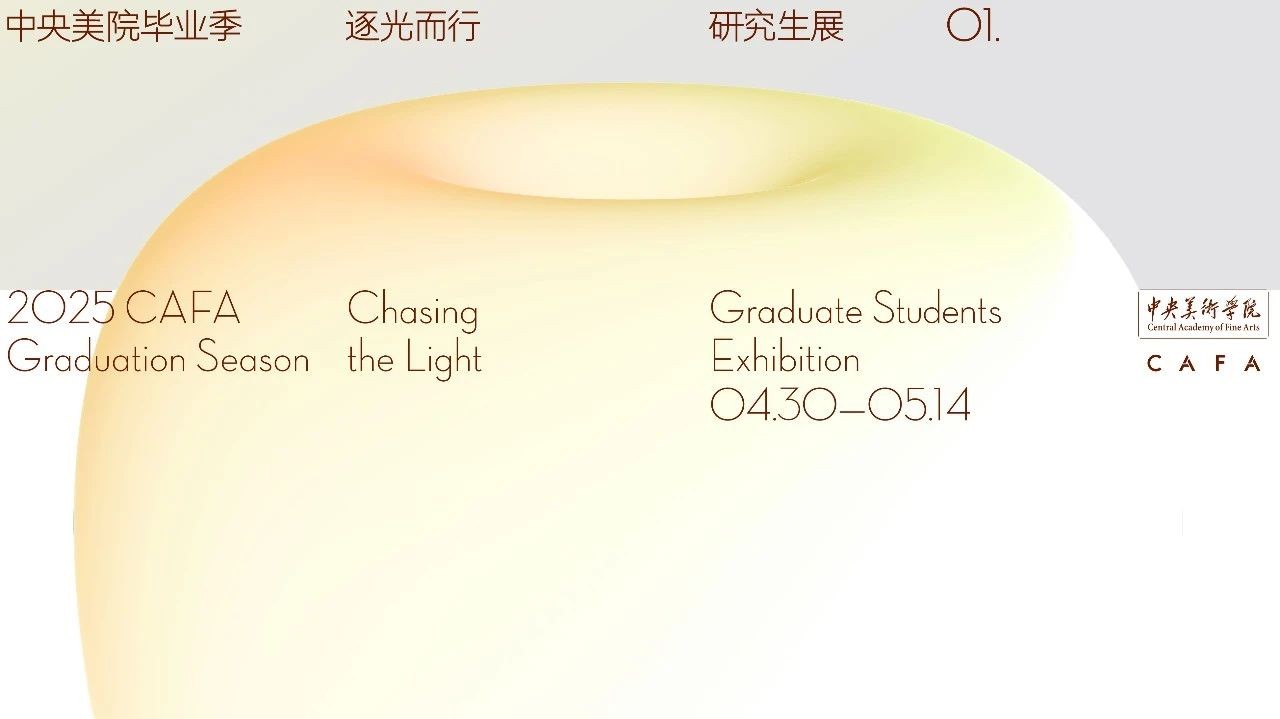


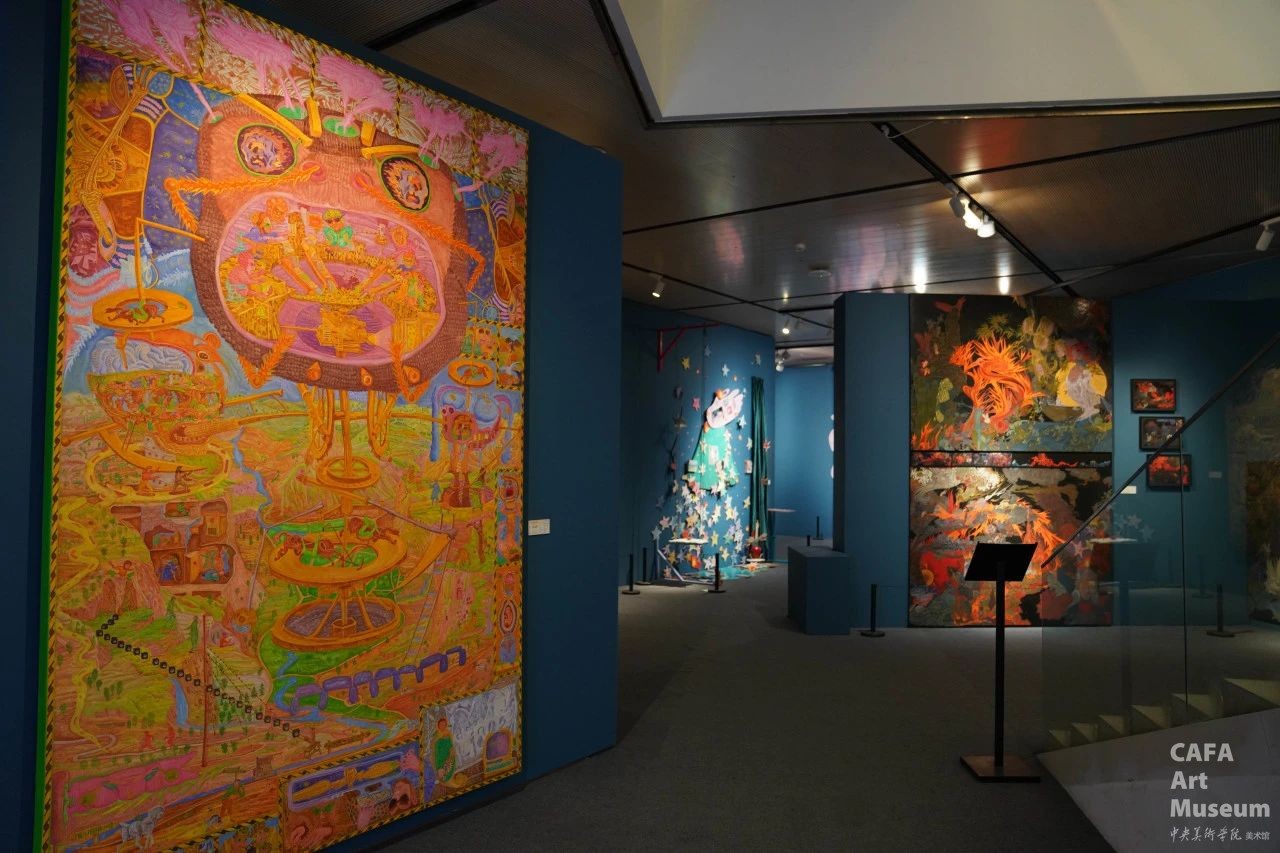

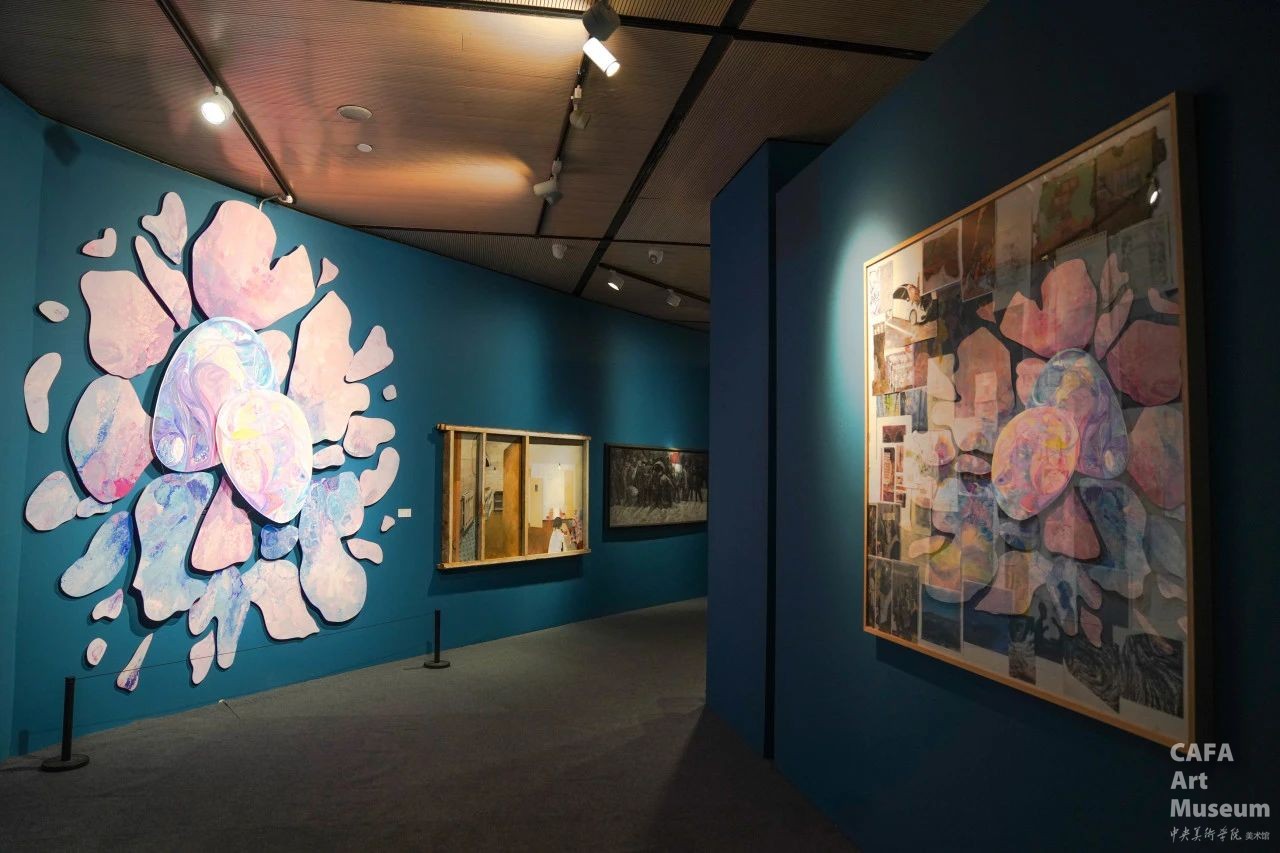
More than 20 graduate students' works from the Mural Department of the Central Academy of Fine Arts have transformed the art gallery into a "flowing mural laboratory". Many different types of creations among them have won the favor of the audience. The exhibition, covering traditional dry murals, tempera, rock paintings, as well as fiber art, relief sculptures, and installations, not only presents the experimental achievements of diverse media, but also takes cultural memory, social structure, life experience and other topics as slices to construct a brand-new path for mural art to intervene in contemporary life.
In this issue, some representative mural works are selected for display. There is more wonderfulness waiting for you to explore on site.
| Friendly Reminder |
The "Graduation Exhibition of Postgraduate Students of the Central Academy of Fine Arts"
will close on May 14.
Friends who haven't visited the exhibition yet, don't miss it!
01
The interweaving and symbiosis of energy
CAFAM@ 2025


作品名称:《云山》系列五联画屏风《云山—扶光》《云山—灵泽》《云山—扶摇》《云山—霹雳》《云山—彼岸》
作者:钟琳
作品材质:木板大漆、岩彩、矿物色、绿螺钿、木樨壳、金箔等
导师:唐晖
Title of the Work: "Cloudy Mountains" Series, a Five-panel Screen Painting ("Cloudy Mountains—Radiant Light", "Cloudy Mountains—Spiritual Moisture", "Cloudy Mountains—Soaring", "Cloudy Mountains—Thunderclap", "Cloudy Mountains—The Other Shore")
Author: Zhong Lin
Materials of the Work: Large-lacquered wooden board, rock colors, mineral pigments, green mother-of-pearl inlay, osmanthus shell, gold foil, etc.
Tutor: Tang Hui
This group of works originates from Zhong Lin's childhood memories in southern Jiangxi. It is a place where plants grow wildly and mountains and forests crisscross. In her childhood, she witnessed the spread of mountain fires and the sudden arrival of floods, and those moments were deeply ingrained in her memory. Years later, these memories fermented in her imagination and became the spiritual starting point for her to construct the world depicted in her paintings.


The entire group of paintings depicts a mythical imagination where a fierce mountain fire collides with the flood at the foot of the mountain, a scene interwoven with destruction and hope, thus extending into a world full of fantasy. The paintings incorporate animal spirits and plant spirits, which together with the author experience a mysterious journey. Taking intangible natural elements such as the sun, rain, wind, thunder, and tears as the main thread, the work starts from the Bodhi tree in full bloom of the Buddha's hand, with the rising sun in the sky symbolizing the beginning of life, and gradually progresses to the other shore where the Manjusaka flower is in full bloom, symbolizing the end of life, thus forming a long narrative scroll about life, death, and reincarnation.
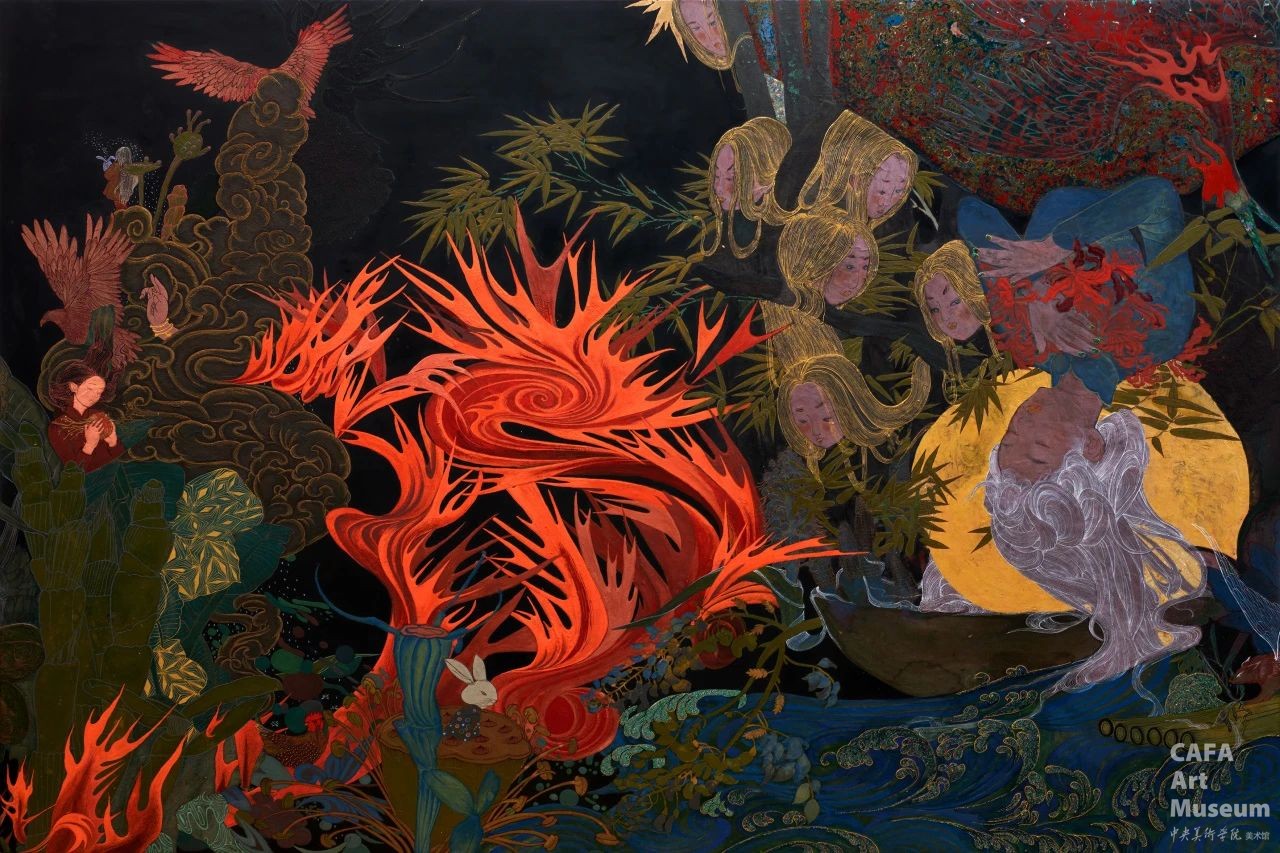
In terms of the language of images, based on the legends of "fire" in the Chinese mythological system, a visual narrative about the outbreak of natural forces has been constructed. Decorative patterns symbolizing fire in traditional East Asian paintings have been incorporated into the paintings to strengthen the spirituality and sense of ritual of fire. In the creative process, the formal language of the shapes of fire in famous works such as the 12th-century painted scroll "Hell Scrolls" has also been borrowed, and these have been reconstructed and integrated with natural images such as plants and mountains, further expressing the interweaving and symbiosis of natural energy and the spiritual world.
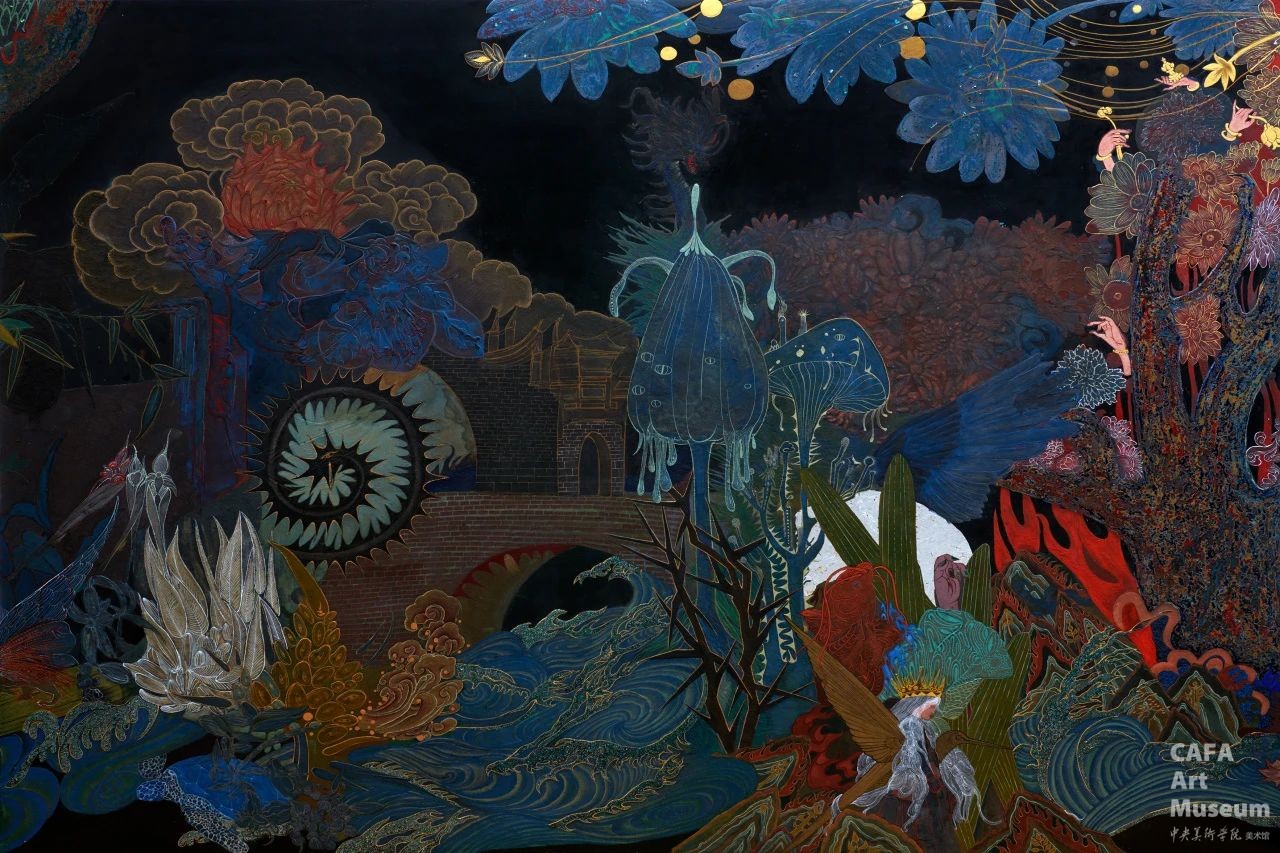

02
Memory and disillusionment, pursuit and return
CAFAM@ 2025
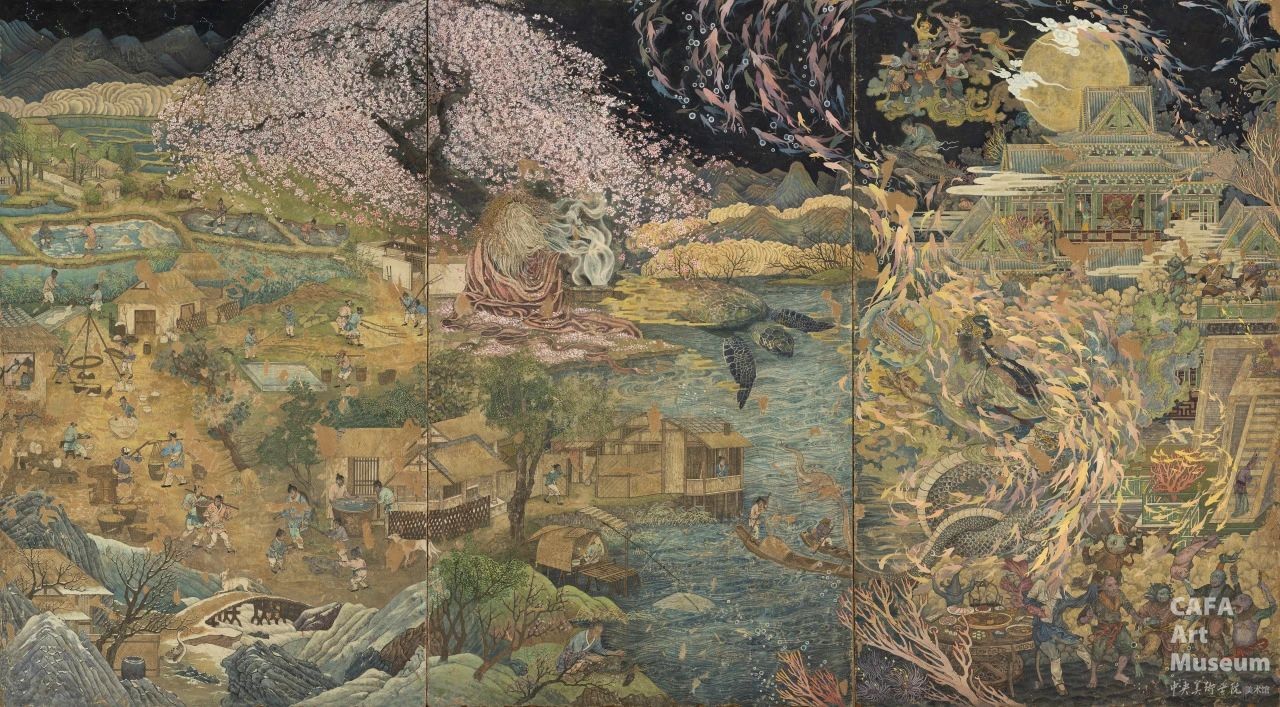
Title of the Work: Like a Man Whose Axe-Handle Turned to Rot upon Returning to His Hometown
Author: Hu Rong
Size of the Work: 360*200 cm
Material of the Work: Loess, Sand, Mineral Pigments
Tutor: Li Yang
Returning to My Hometown and Feeling Like the Man with the Rotten Axe Handle" comes from Liu Yuxi's poem "Presented to Bai Juyi at a Banquet upon My Return to Yangzhou". The allusion of "the rotten axe handle" is from "Records of the Unusual". It tells the story that in the Jin Dynasty, a woodcutter watched immortals playing chess in the mountains. Without realizing it, hundreds of years had passed. The handle of the axe in his hand had long rotted away, and everything in his hometown had changed completely. The author Hu Rong mentioned that during his childhood Chinese class, he only understood the lines "By the sunken boat a thousand sails glide past; before the sickly tree ten thousand saplings thrive". Now, he suddenly realizes that he has become "the man with the rotten axe handle".
The work is composed of three mud slabs, with a total length of 3.6 meters and a height of 2 meters. Employing the traditional technique of dry mural painting in ancient China, it makes use of loess, sand, gelatin, ink, and mineral pigments. The painting is created by sketching with ink and layering colors. It took eight months to finally complete.

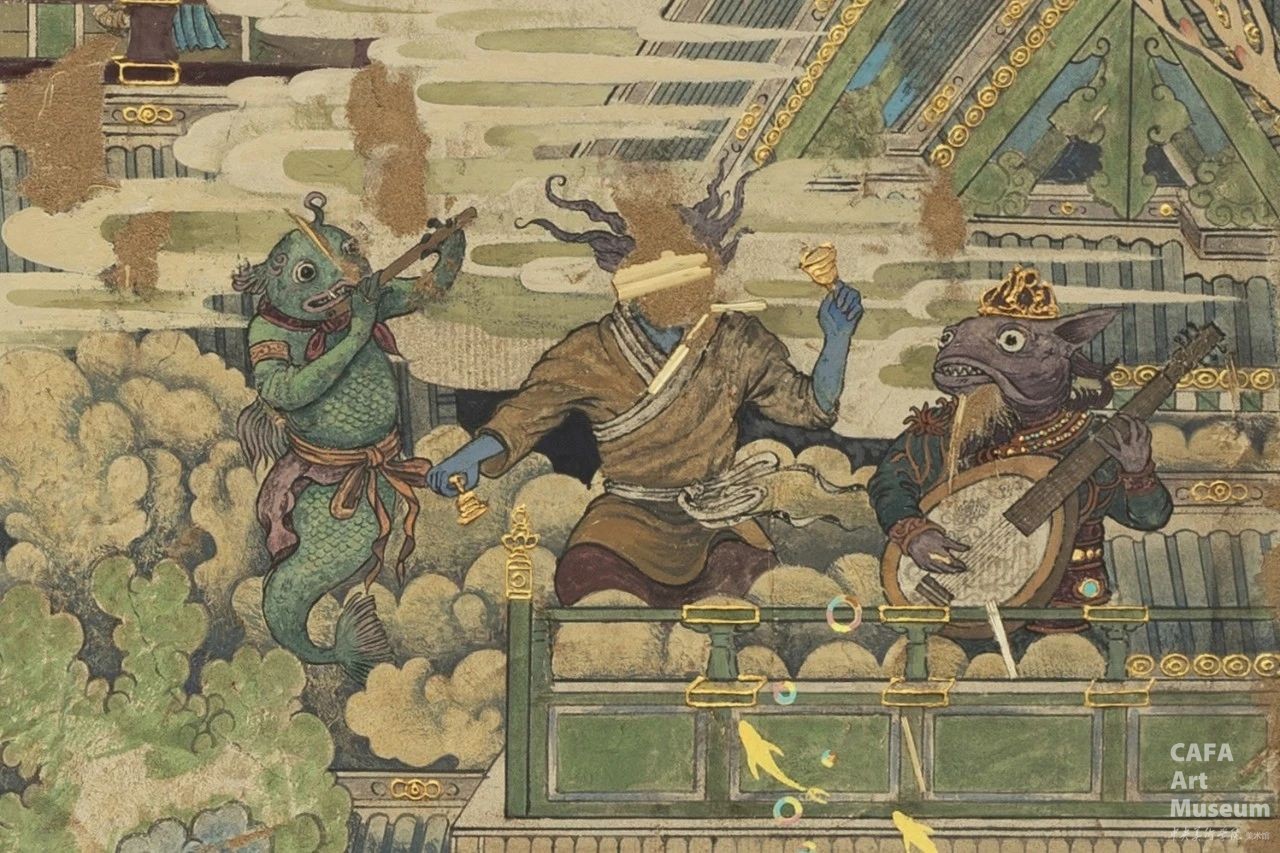
The picture depicts a fisherman who, on his way back after fishing, rescues a sea turtle from a child and releases it back into the sea. A dragon princess, out of gratitude, invites him to take a tour of the underwater Dragon Palace and treats him warmly. They have a happy time together. One day, the fisherman decides to return to his hometown. The dragon princess gives him an exquisite treasure box and warns him not to open it no matter what. When he comes ashore, he finds that time has passed, his familiar hometown is no longer there, and his relatives and friends are nowhere to be found. Overwhelmed by helplessness and despair, he can't help but open the treasure box. A wisp of white smoke gushes out, and the fisherman instantly turns into an old man with white hair. This is the legend of Urashima Tarō written by the Japanese Sinologist poet Ma Yang.
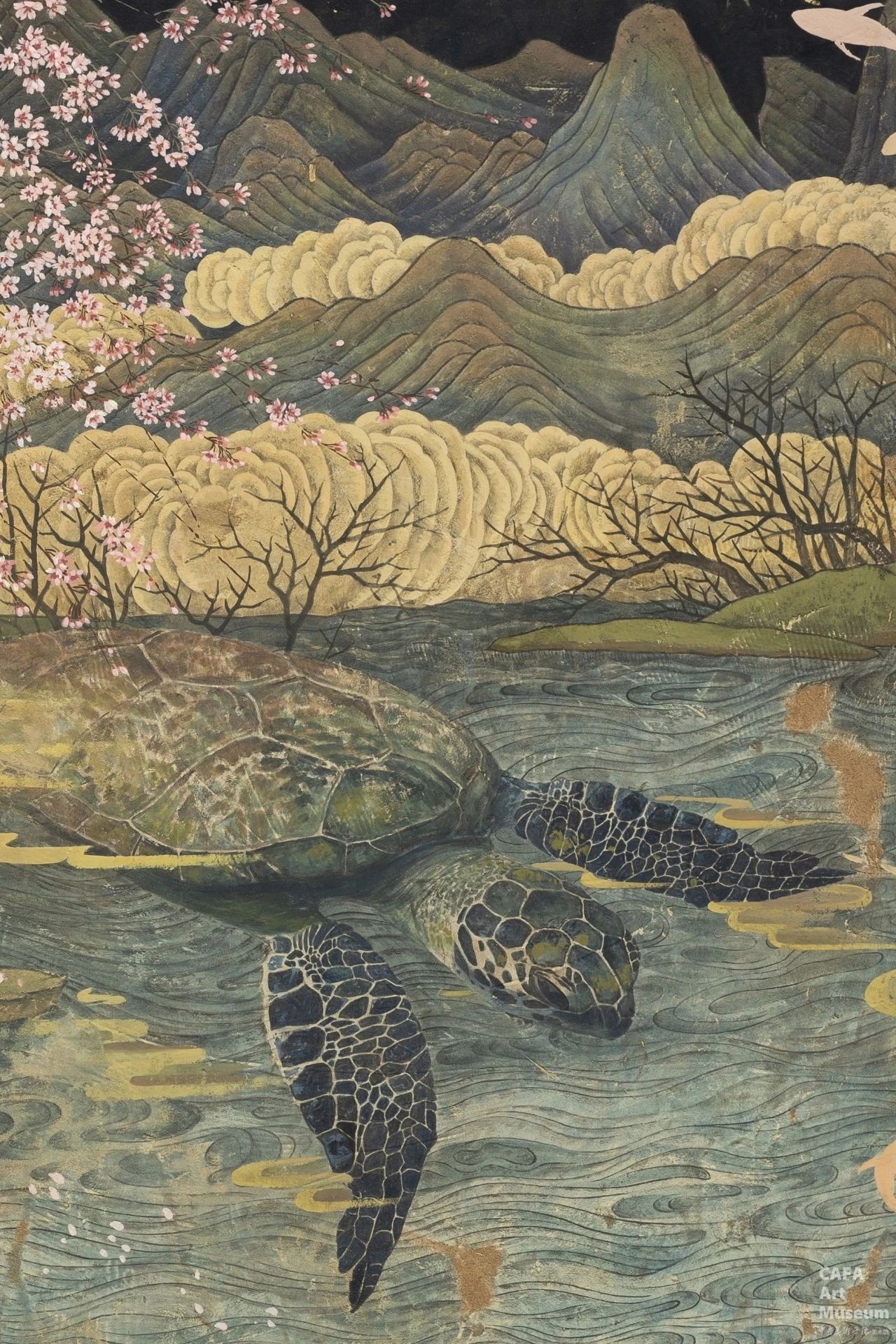
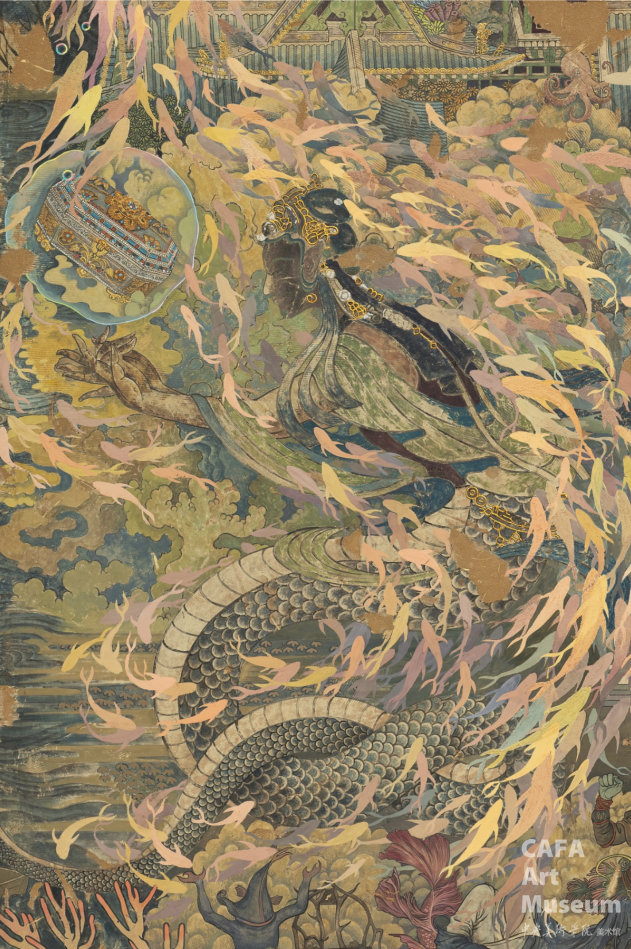
The legend of Urashima Tarō has been significantly influenced by ancient Chinese civilization. Plot elements such as a mortal visiting the Dragon Palace, a dragon princess repaying a kindness, and a temporal dislocation are also found in works like "Annotations to the Waterways Classic", "Sequel to Records of the Supernatural", "The Story of the Dragon Princess", and "The Story of Liu Yi" among the supernatural tales. Hu Rong chose this story as the source of inspiration. It is not simply a reproduction of a foreign-themed story. Instead, through this fable and cross-cultural narrative symbols, Hu Rong expresses his own life experiences of studying in Beijing and going through family changes, explores the fluidity of individual memory and identity, demonstrates the subtle and profound connection between the individual and the world, and presents an inner journey about memory and disillusionment, pursuit and return.
03
Explore the answers to life
CAFAM@ 2025
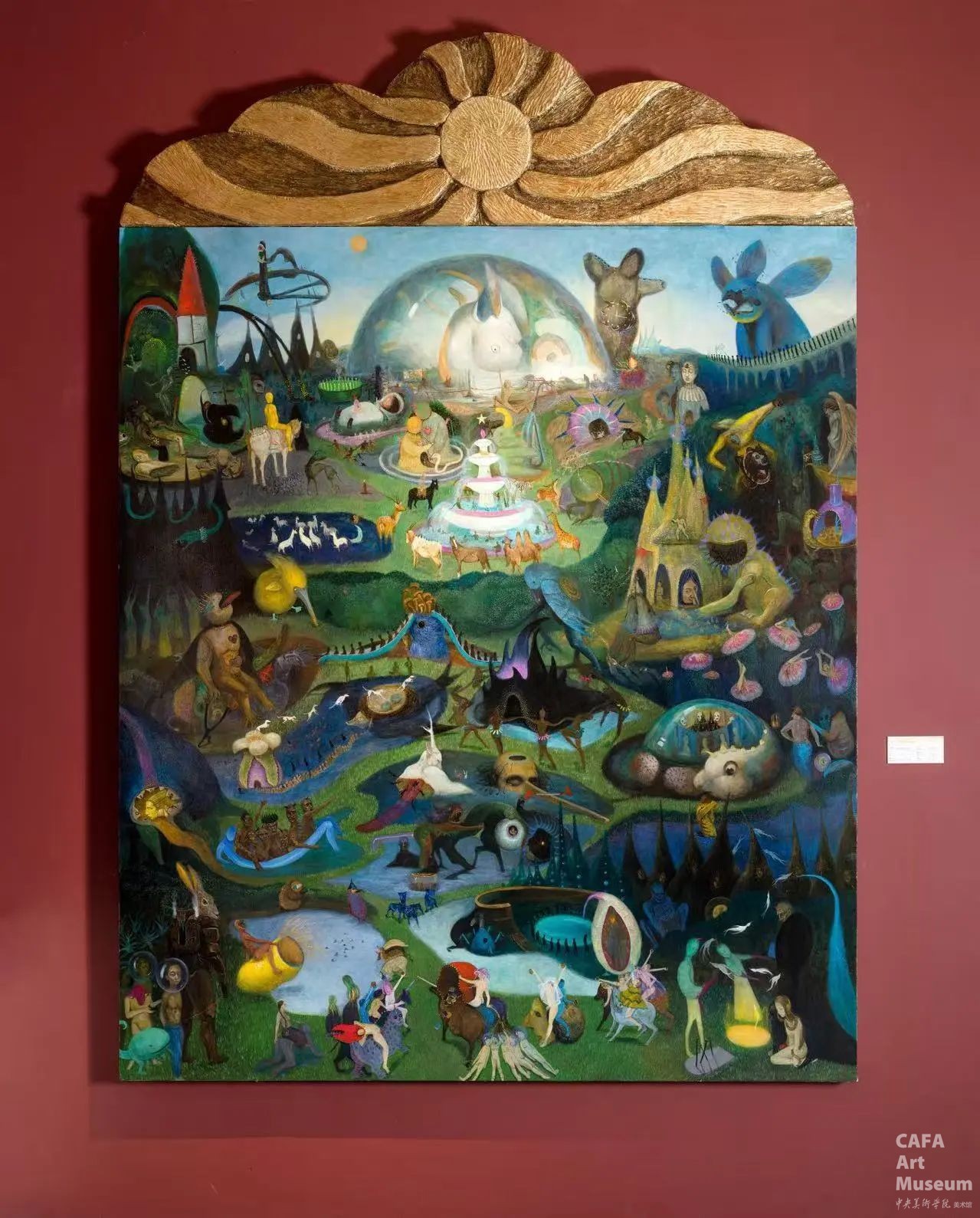
Title of the Work: "Mayflies Gazing at the Clear Sky"
Author: Wang Jinyu
Size of the Work: 220*195 cm
Material of the Work: Oil Painting, Woodcarving
Tutor: Ma Gang
The author conducts a deep-level dialogue with the world through the work "Mayflies Gazing at the Clear Sky". In the form of a diary of the era, using "I" as the carrier and taking the real-life events heard and felt as samples, the author ponders over the current era and reveals the pain at the individual spiritual level. In the "amusement park", everyone rushes to the wishing pool with an "admission ticket" (gold coin). The wishing pool in the central position carries people's expectations for the future and their endless desires. The flowing water implies that the wishes seem to be never fulfilled. People wander in this amusement park, floating, enjoying, getting lost, and undergoing changes in the whirlpool of desire.
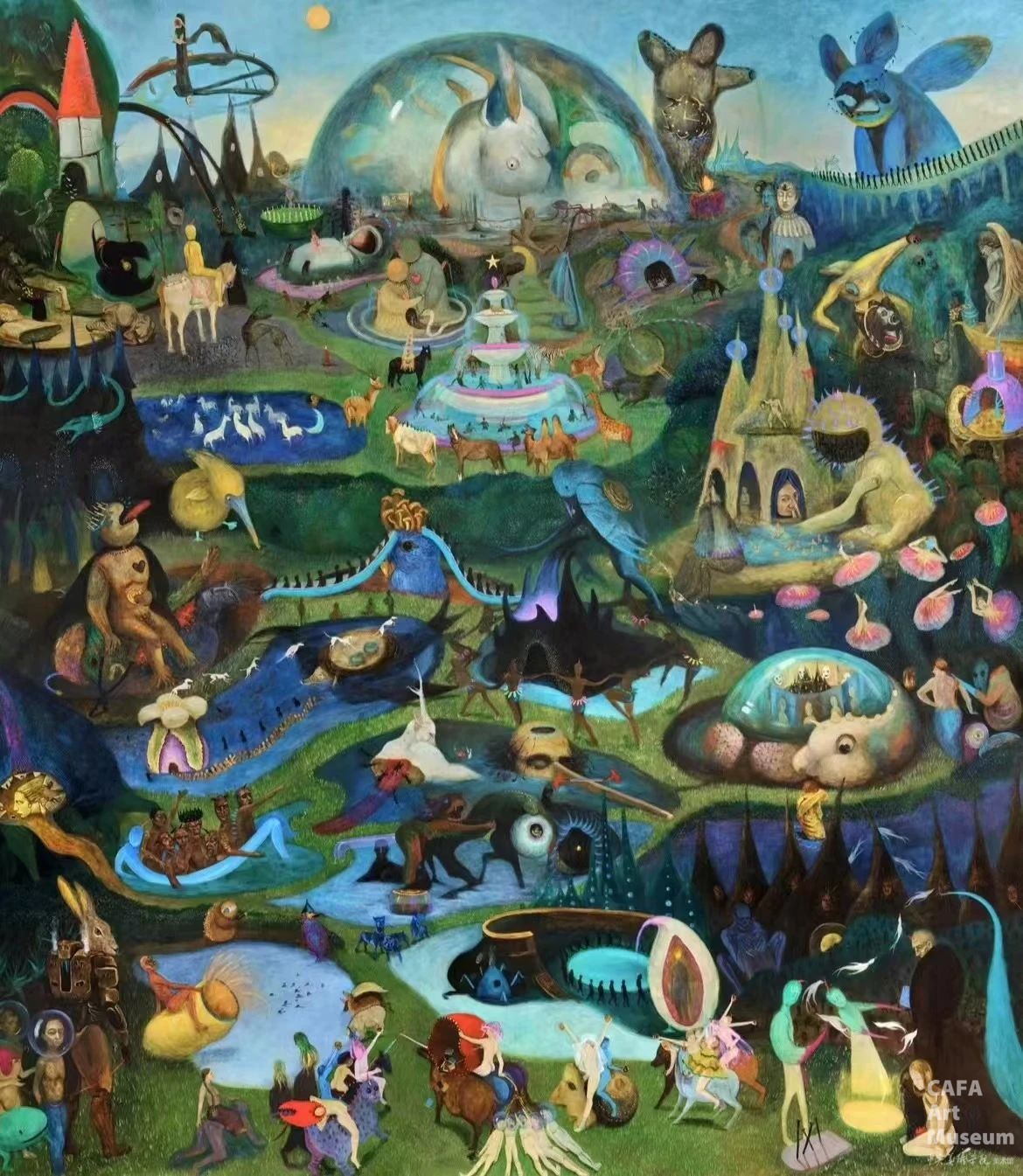
The moment when new life peers out from the river water resembling amniotic fluid in the lower left corner, life and death achieve an eerie reconciliation visually. In the lower right corner, there is death and burial. It seems that people are unable to escape the impermanence of fate. In the world within the turtle's enclosure, there are seven strange people on the ship of fools, a giant whose wisdom has been stolen, a maiden who has buried her own soul, an "ant" that wishes to soar into the sky, a mermaid who has been petrified after believing in love, a woman trapped by upbringing, lovers who embrace but hurt each other, dancers surrounding the building, a frog in the well being pulled out and tortured, a frogman who has won the hunt but can no longer move, a bird that refuses to be a tool of differentiation, a discarded book, a scholar who has shed his long gown... Each distorted entity is a slice of the real-life illness. In this amusement park, some people dance with shackles on, while others dismantle their shackles and are reborn. Here, there is both life and death, as well as struggle and hope.

The gold foil mirror in the center of the woodcarving incorporates the viewer into the closed loop of the narrative, reflecting the projection of the mayfly of oneself and the real world. The shape of the sun represents the courage to face fate and embrace life in the face of death, and it is the sudden enlightenment after "seeing the clear sky". There is no complete image of a mayfly in the painting, but the "mayfly" can be found everywhere in the painting, and every viewer in front of the painting is also a "mayfly". This is a discussion about me seeking the answers to life, and it is also a path for every soul to find self-reconciliation.
04
A Healing Space for Inner Peace
CAFAM@ 2025
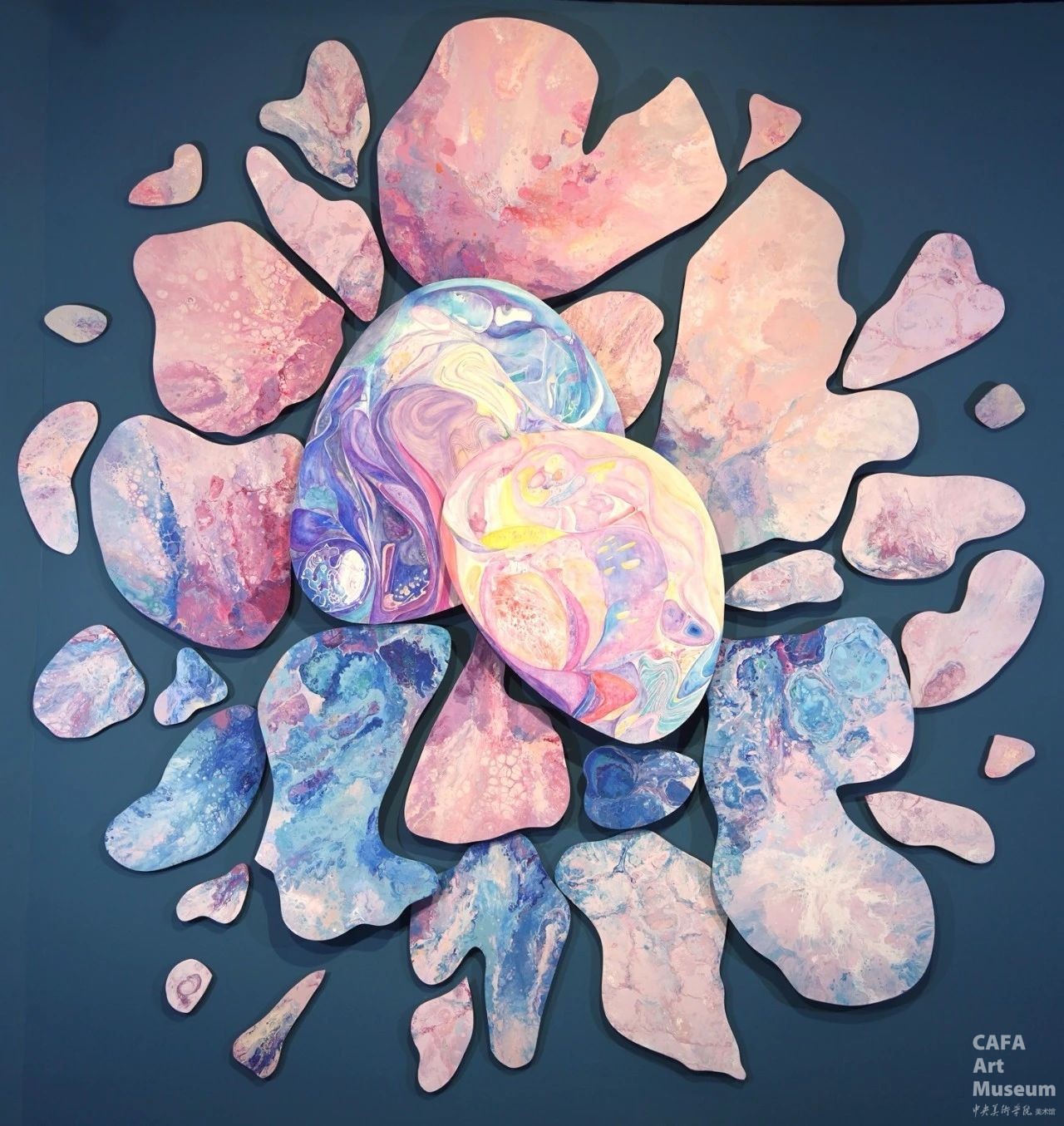
Title of the Work: "Maimu"
Author: Cai Wanzhen
Size of the Work: 330*330 cm
Material of the Work: Watercolor, Acrylic
Tutor: Cao Wei
"Maimu" takes inspiration from the gentle rain described as "moistening all things without making a sound" in The Book of Songs. It uses watercolor and acrylic to create flowing pinkish-purple lines. The colors naturally blend along the watermarks, and the overlapping light and shadow transform the hazy rain imagery in classical poetry into a contemporary art language.
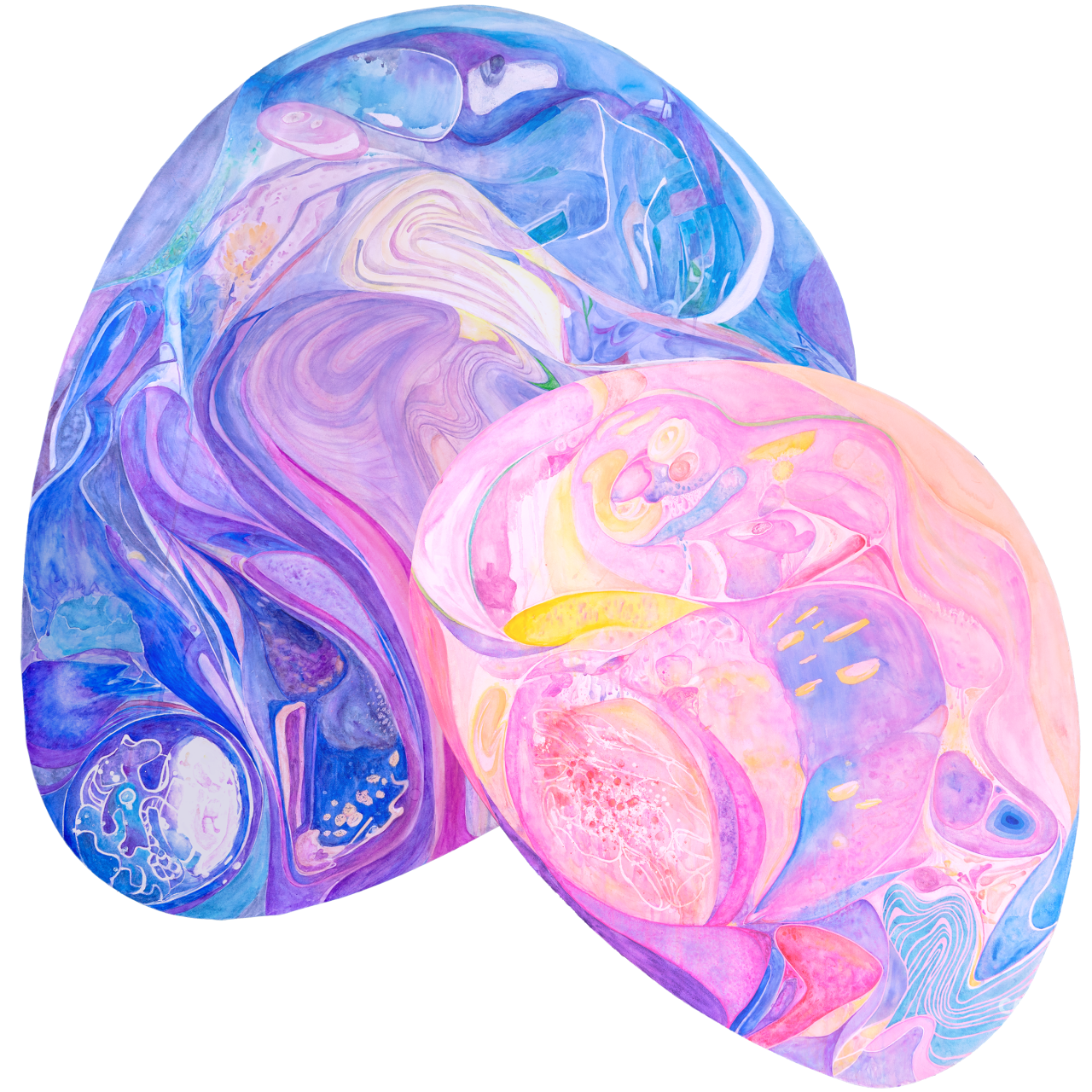
In the current situation full of anxiety, through the changes of light and shadow and colors, a healing space is constructed for the audience, where they can feel at peace and relax both physically and mentally.
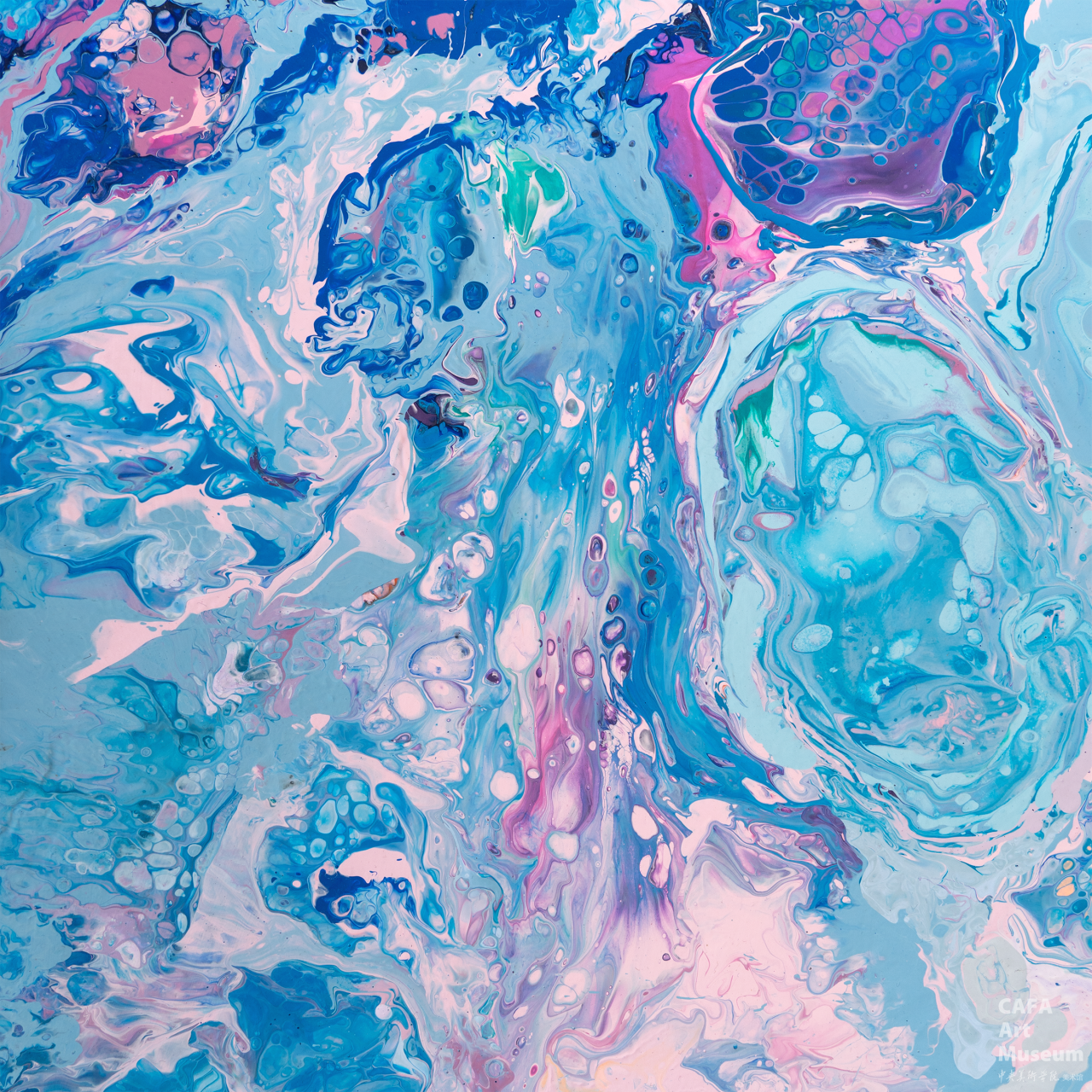
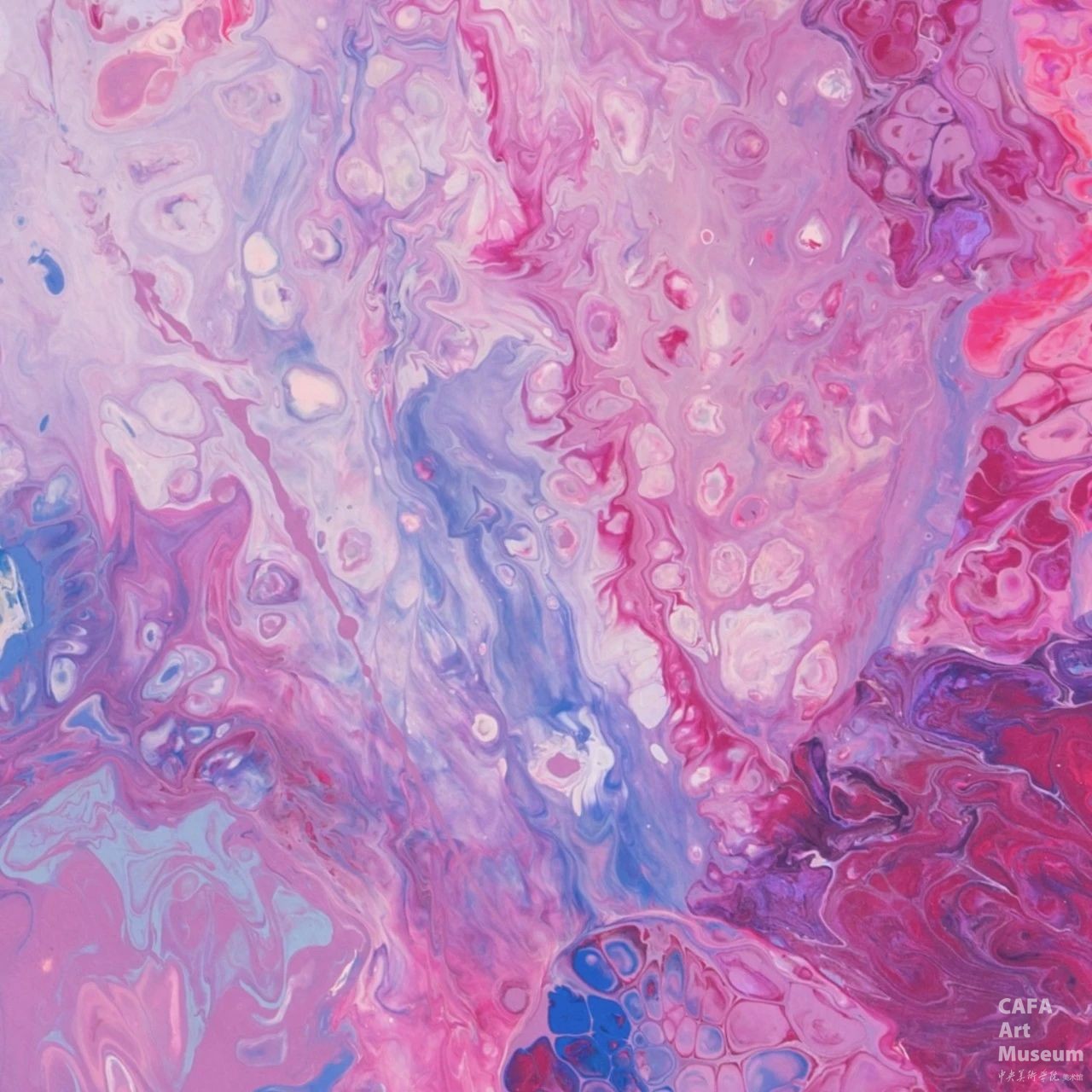
05
Social metaphor
CAFAM@ 2025
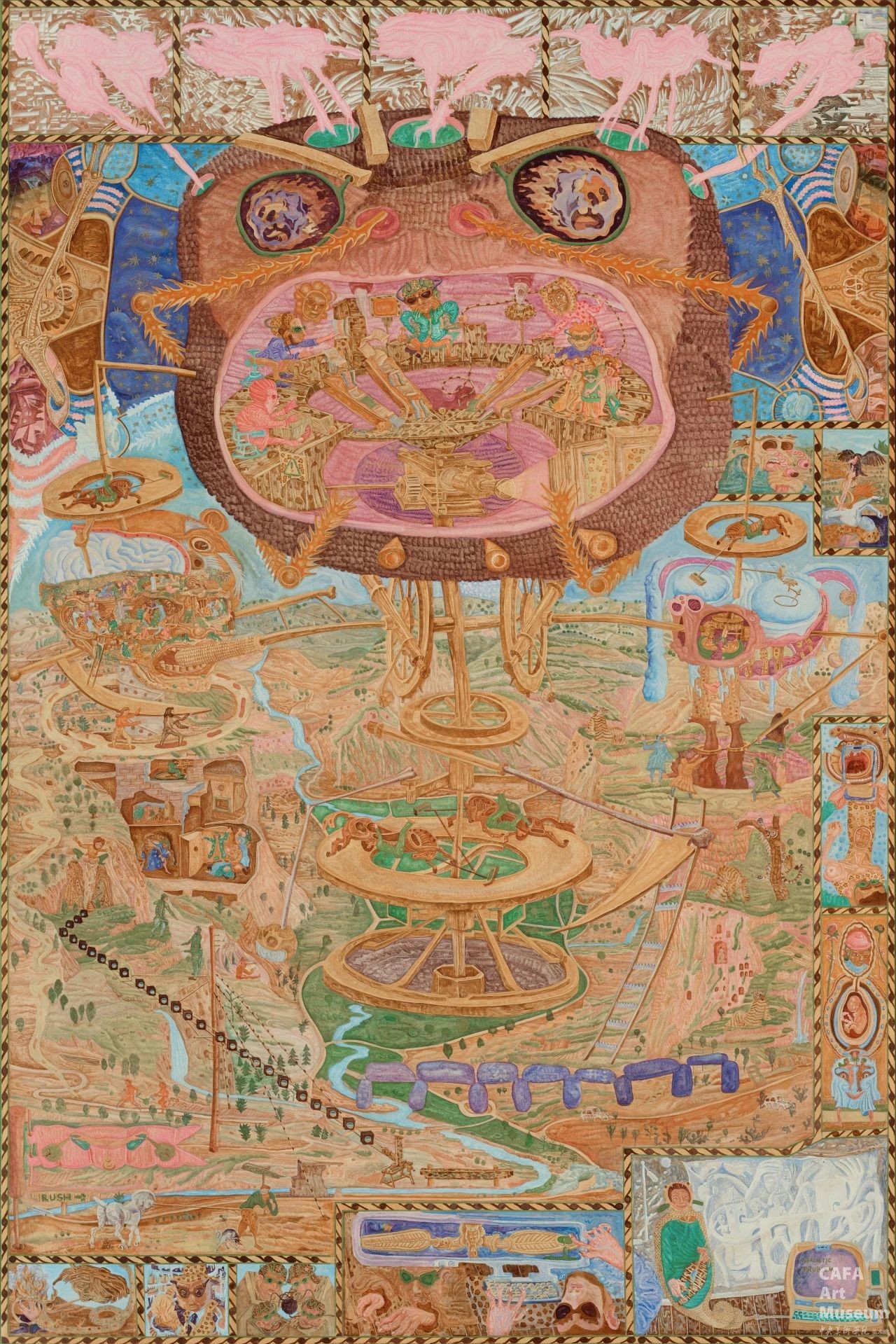
Title of the Work: "uncanny"
Author: Li Jinyang
Size of the Work: 200x300 cm
Material of the Work: Oil Painting on Canvas
Tutor: Li Yang
"Uncanny" is a feeling that is both familiar and strange, and is unsettling. It is also a social structure and a social metaphor. It revolves around the core image similar to an insect. All parts of the image are closely connected through the limbs of the insect, forming a structure that establishes connections between the images and creating a logical spatial narrative.

At the center of the picture is the body of an insect. The source of its life or motivation comes from hunger and thirst. A person is drinking horse milk. In short, the horse is constantly in a state of physical strength depletion. There is a green display screen on the horse's head. This green color keeps stimulating the horse to keep running until the end of its life. This kind of motivation keeps the entire structure in operation.
06
The contradiction between the individual and social discipline
CAFAM@ 2025
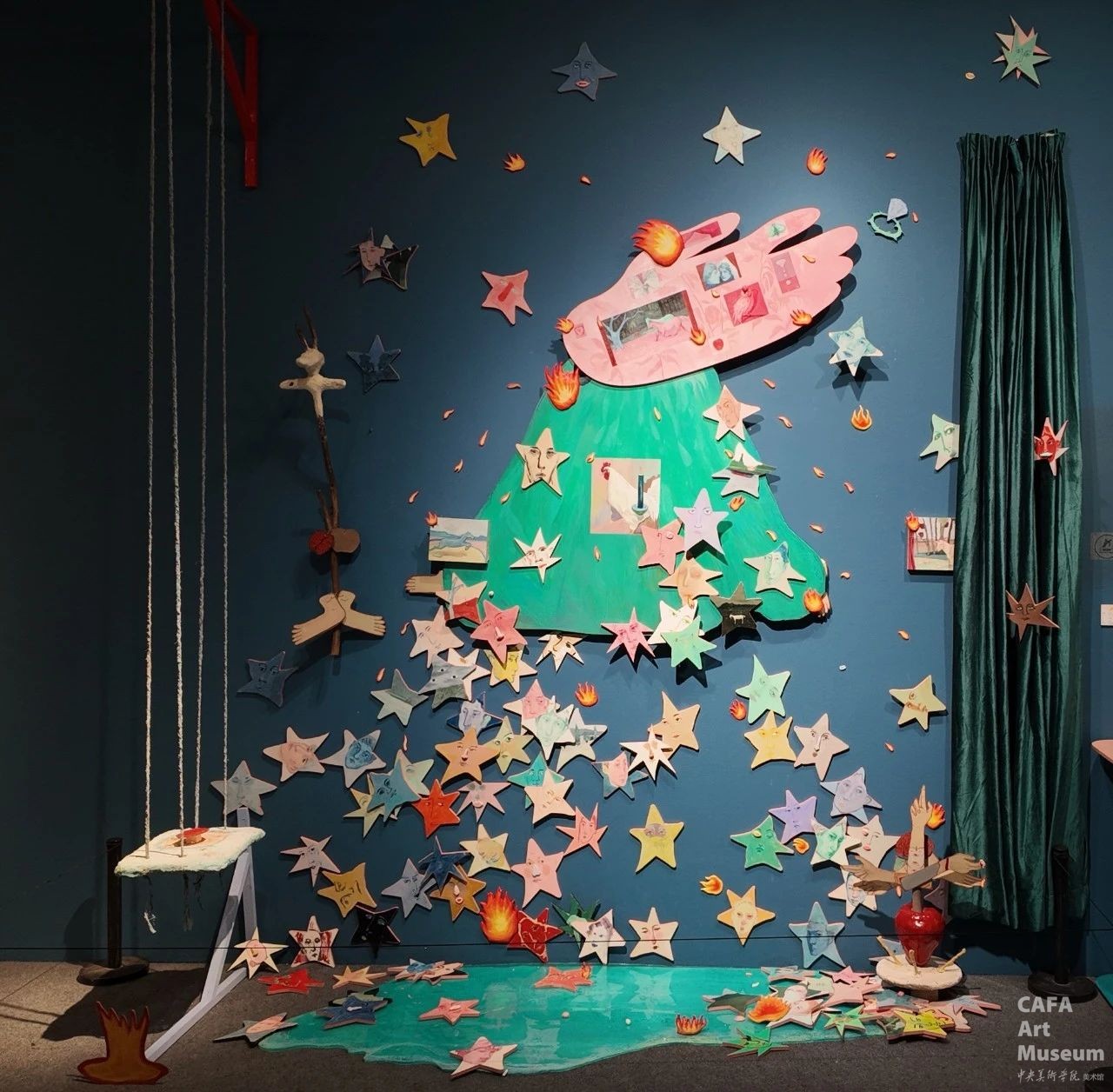
Title of the Work: "Urgent! Don't Be Hasty."
Author: Wu Jianghong
Size of the Work: 290x300 cm (variable)
Material of the Work: Wax, Quartz Sand, Clay, Oil Painting
Tutor: Li Chen
"Urgent! Don't Be Hasty." constructs a stage play-style scene, exploring the contradiction between the individual and social discipline from the anxious, impatient and involutionary state of the current young people. A theater is originally a performance designed by humans. It can create contradictions and oppositions to divert people's attention, causing us to overlook the structural problems.

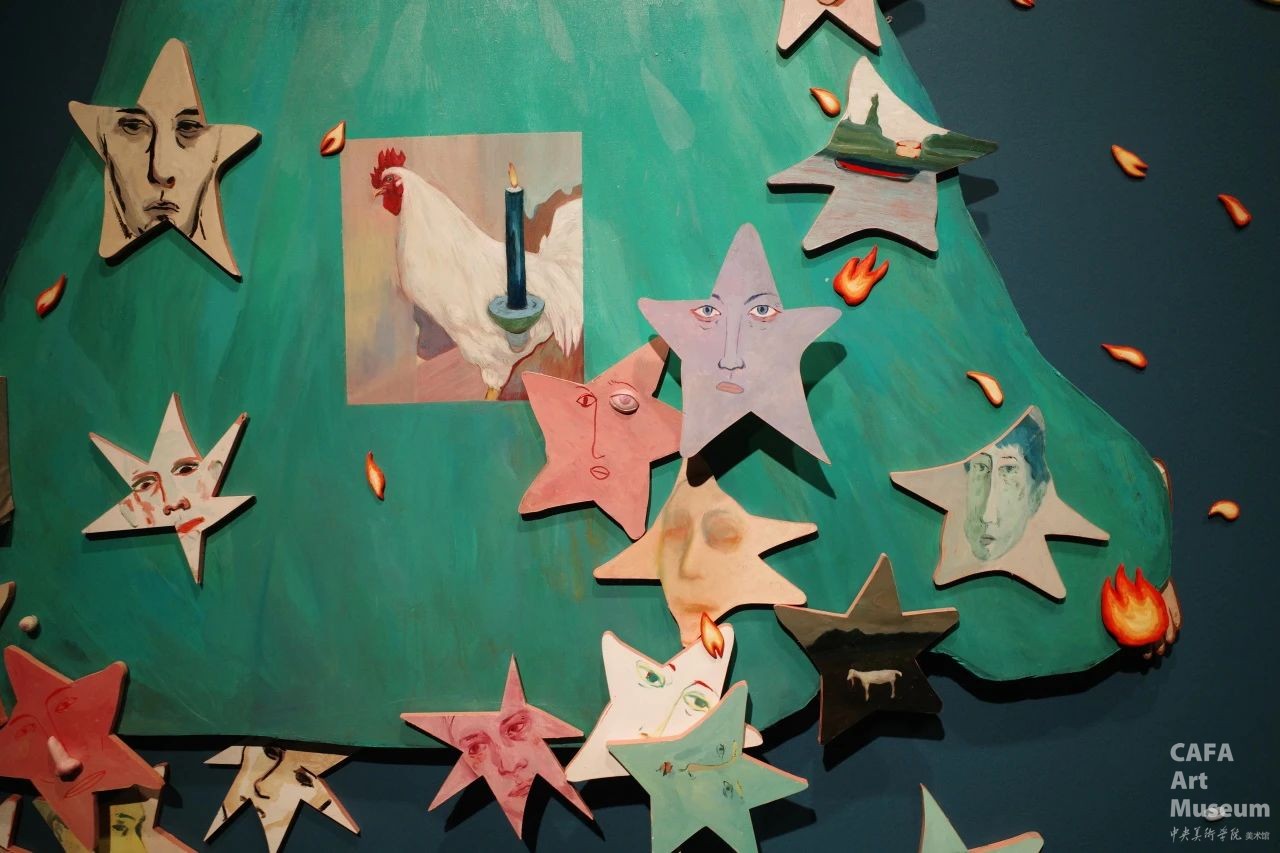
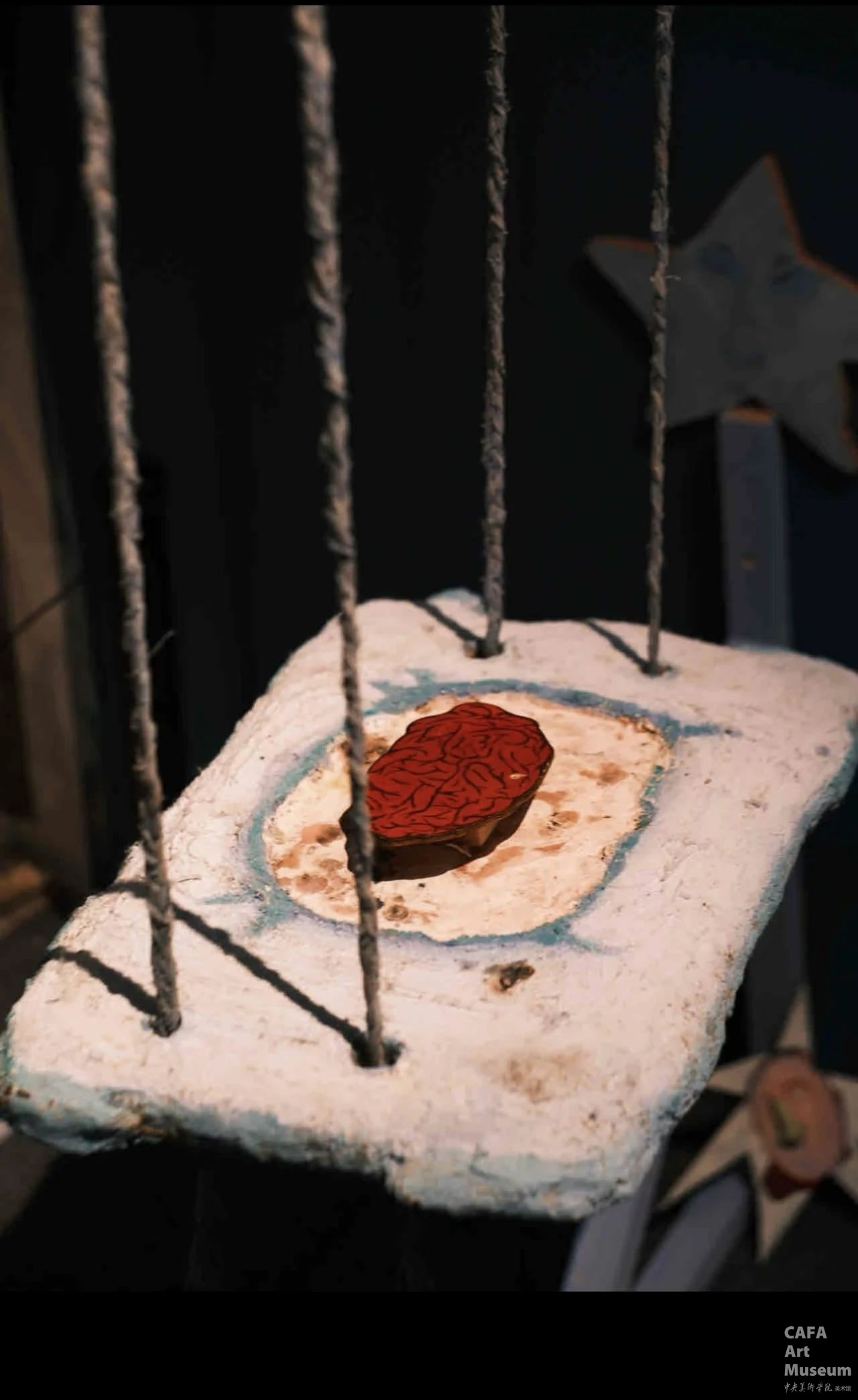
The swing sways gently back and forth with the change of air pressure, much like our current state. Everyone is caught up in this environment and is forced to be anxious, impatient and involved in the involution. The fast-paced life makes us ignore the true essence. Just like the stars in the sky, they are artificially defined as romantic and beautiful. Once we truly understand them, we will be disenchanted and sigh with emotion: So that's how it is.
07
Reconciliation between Reason and Desire
CAFAM@ 2025
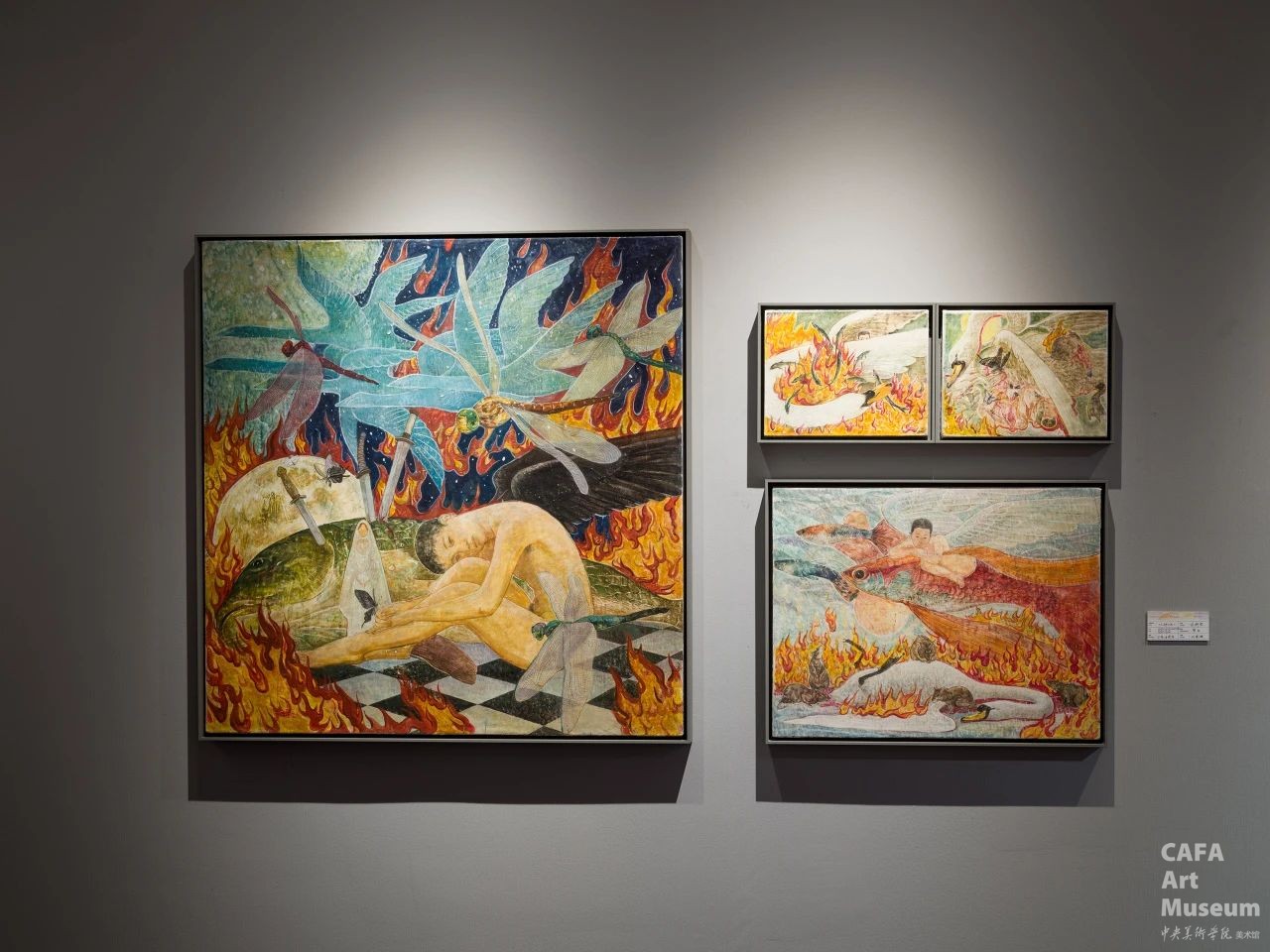
Title of the Works: "The Death of the Swan" I, II, III, IV
Author: Hou Shuyi
Sizes of the Works: 120x120 cm; 60x80 cm; 30x40 cm x 2
Tutor: Liu Xiaohui
The swan imprisons the spark of Prometheus. The genuine desires are disciplined into institutionalized shoals of fish. The soul is weathered by the sound of clocking in and out into a steel blade of symbols, which eventually stabs into the swan's chest. When the swan dies, the clock of reason stops. The herds trample on the reflection of the curtain wall, and the ancient tide of blood easily overflows the high walls of rational civilization. The soul wanders in the crevice between the iron jungle and the blood-colored wasteland. In the left hand is a pale specimen of alienation, and in the right hand is a chaotic totem of revelry. What fills the chest is nothing but the rusted moonlight.
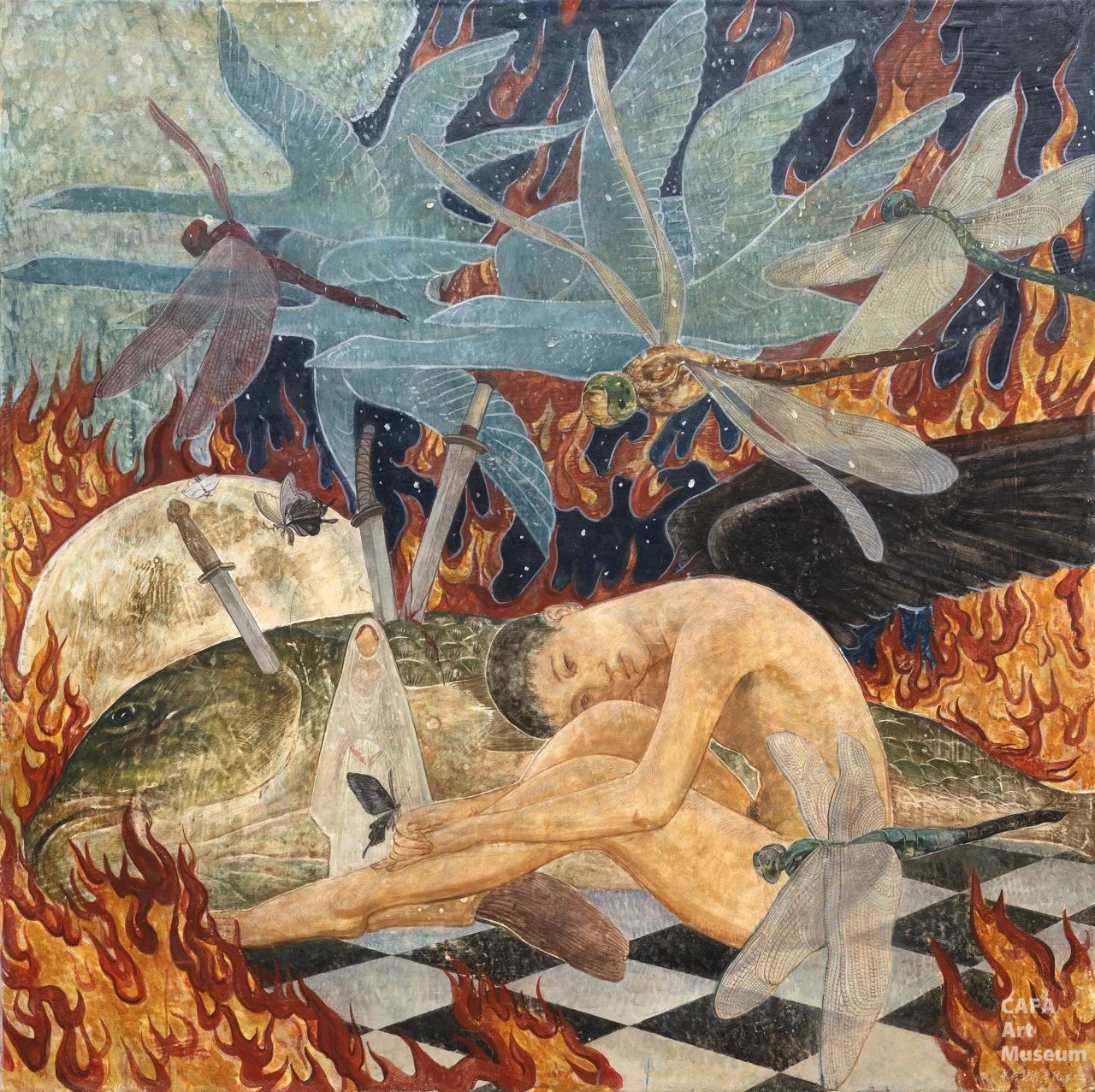
The "The Death of the Swan" series is a work created by the author based on his own life experiences and reflections. In this work, following in the artistic footsteps of Blake, he attempts to establish another universe parallel to the real world to reflect the living conditions of people in the real world.
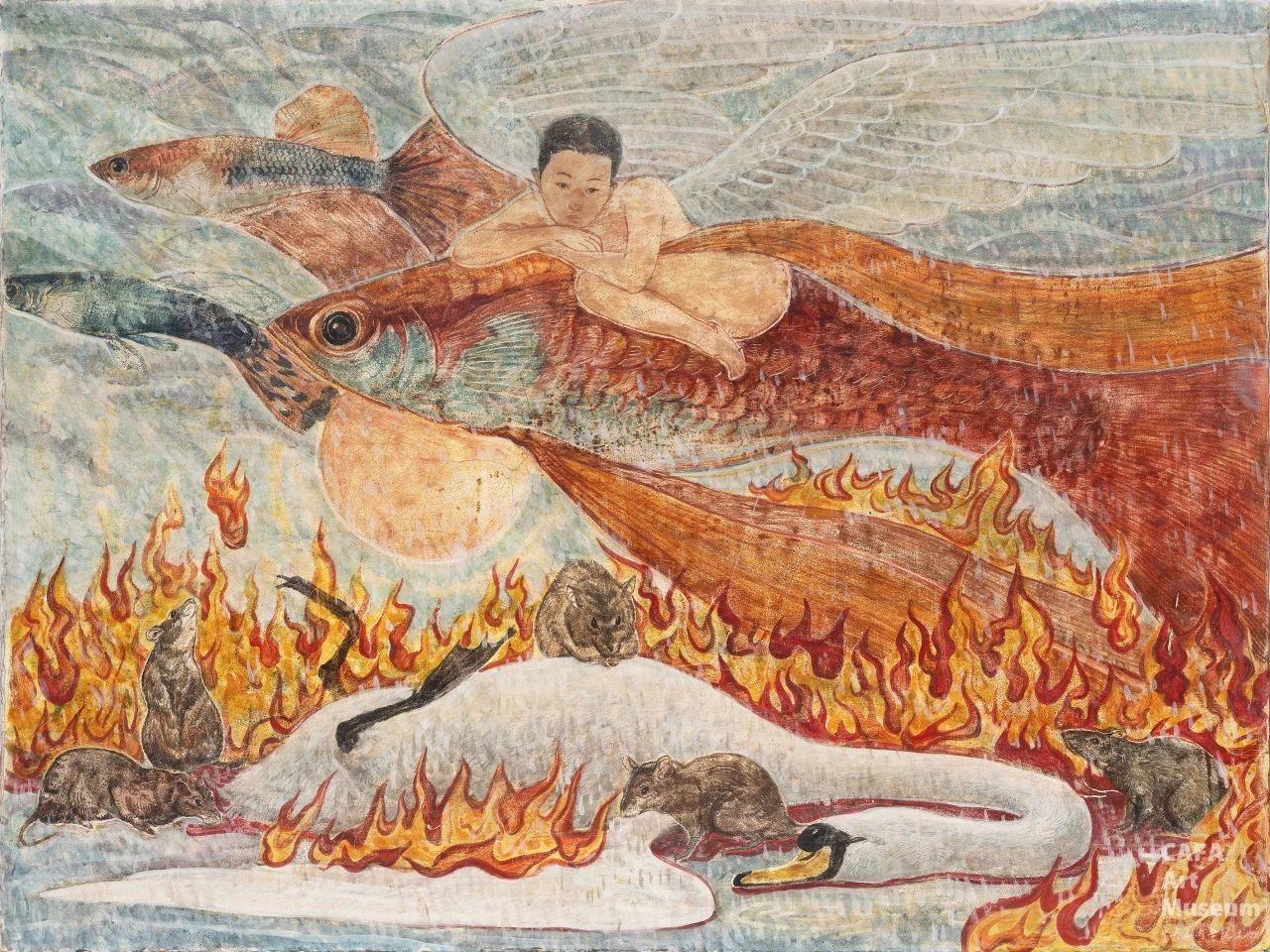
Through the interweaving of elements such as fish, swans, bodies, herds of beasts, and flames, the work expresses the relationship between human desires, rationality, the physical body, and the spirit. It also attempts to embody the theme that "desire is the dialectical unity of scarcity and excess". Among them, the swan is the embodiment of rationality. Its elegance disciplines the primitive desires like flames, and desires turn into institutionalized shoals of fish. However, when the swan loses control over the management of desires, the primitive desires will break through the dam of civilization, transforming into herds of beasts and sharp swords that bring about the death of the swan and ideals, plunging the spirit and soul into a whirlpool of confusion and entanglement. Only by allowing imagination to serve as wings, accepting desires, and promoting the reconciliation between rationality and desire can the soul break free from the whirlpool of confusion and attain true freedom.
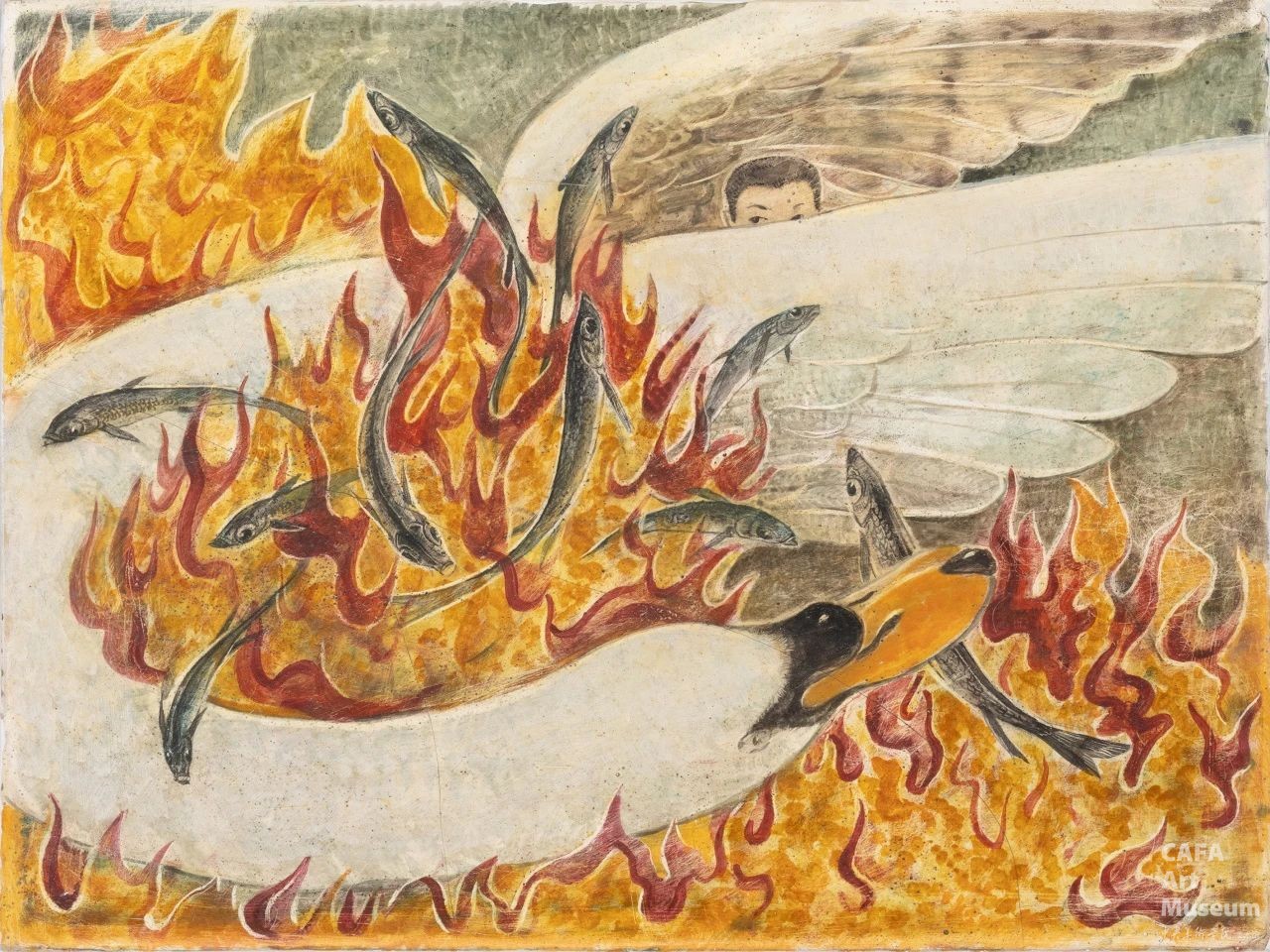

09
Find your own light
CAFAM@ 2025

Title of the Work: "Notice of Searching for Light"
Author: Gao Chenxi
Size of the Main Work: 130×170 cm
Material of the Work: Oil Painting on Canvas
Tutor: Ye Jianqing
In ancient China, deer often symbolize longevity, wealth and freedom, and they are also symbols of spirituality, kindness and purity. In the West, due to their liveliness, sensitivity and ability to run quickly, deer also carry the meaning of "guide". Therefore, I have chosen the deer as the main image. It serves as the carrier of kind and pure souls. Even if it is lost in confusion at the moment, as a guide, the deer can ultimately find its way in the dense forest.
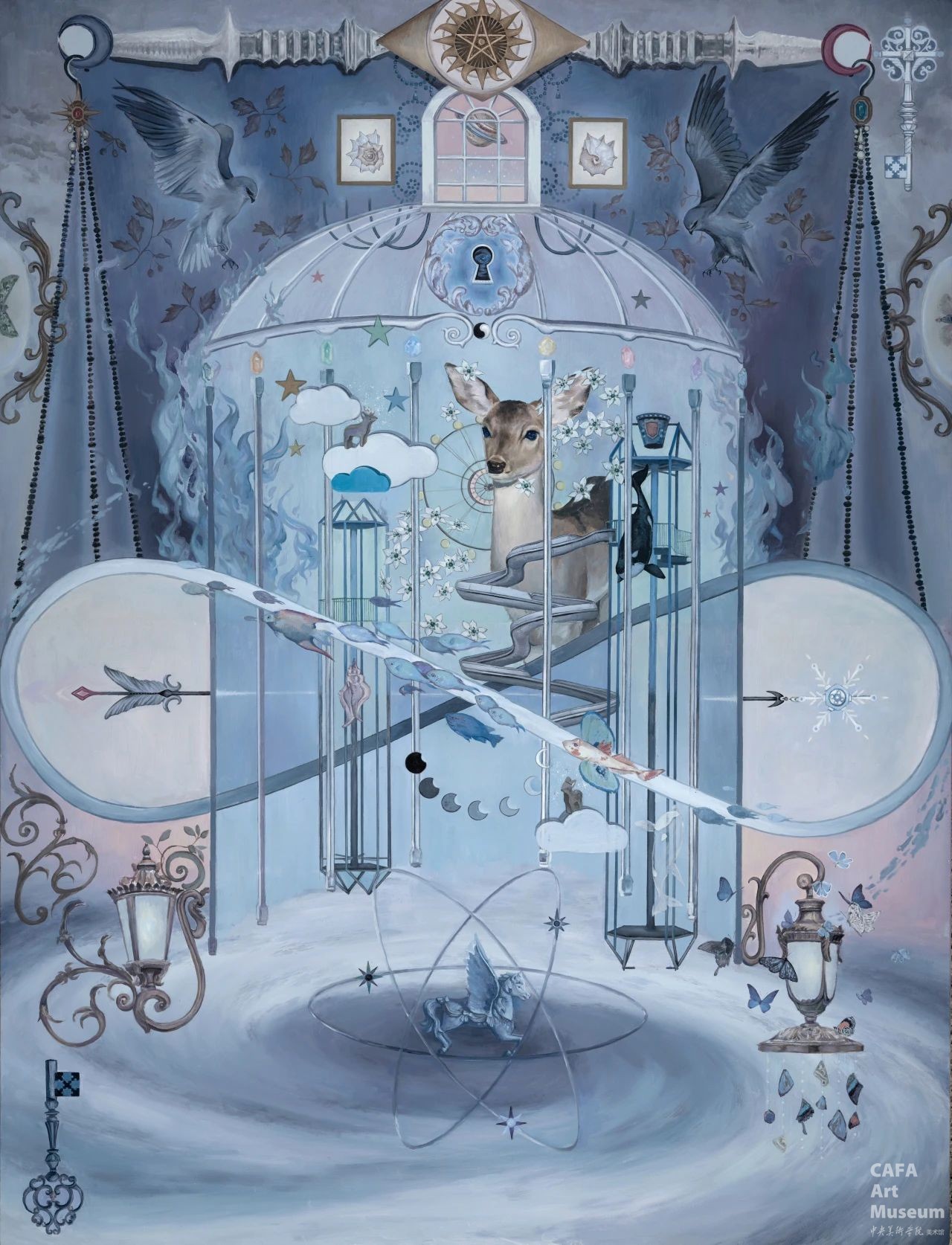
The flowers surrounding the deer are Star of Bethlehem. Their flower language represents pursuit, cherishing, hope and purity, forming a quiet magnetic field around the kind little deer. The circular water patterns and the fish with various postures swimming in the water convey the message that life goes on in a cycle. Life and death are not simply the beginning and the end, but rather a continuous cycle.
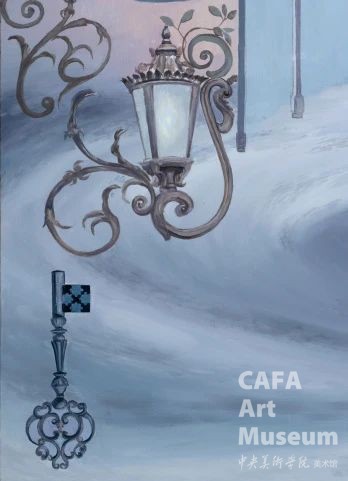
The keys in the corner of the painting, one above the other, represent countless possibilities and dreams. Everyone will find their own key and unlock the final lock.
10
Pure formal language
CAFAM@ 2025
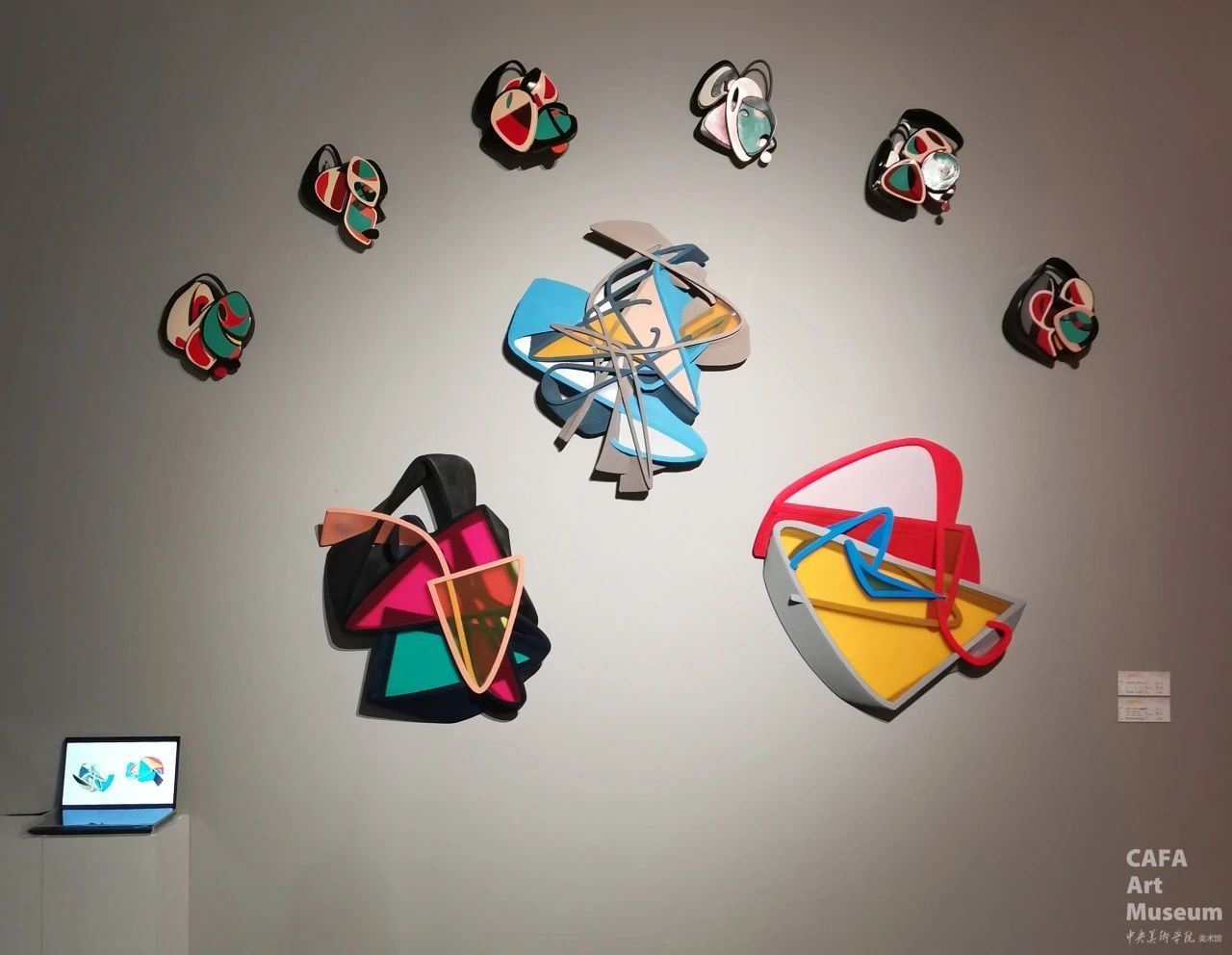
Title of the Works: "The Ocean", "Fireworks", "Composition of Red, Yellow and Blue", "Gesture Form: Topology of the Heart Symbol" (6 pieces)
Author: Yang Xiaoyu
Tutor: Qi Peng
The three works below, "The Ocean", "Fireworks", and "Composition of Red, Yellow and Blue", generate dynamic line trajectories through programming algorithms. After freezing these trajectories into two-dimensional images, 3D modeling technology is used to transform the planar paths into three-dimensional relief structures. Taking the line movement data as the framework, the creator constructs multi-dimensional depth through spatial imagination, materializing the traces of time into an interlaced physical space structure. The creation focuses on the pure formal language – reconstructing dynamic traces with minimalist geometry, and simulating the techniques of gestural painting. By ensuring the mathematical order of the structure with numerical control precision, the random rhythm derived from the algorithm is also retained. The sense of mechanical precision and organic fluidity reach a balance on the surface of the relief, ultimately presenting a mechanical poetic quality where rational codes and physical forms permeate each other.
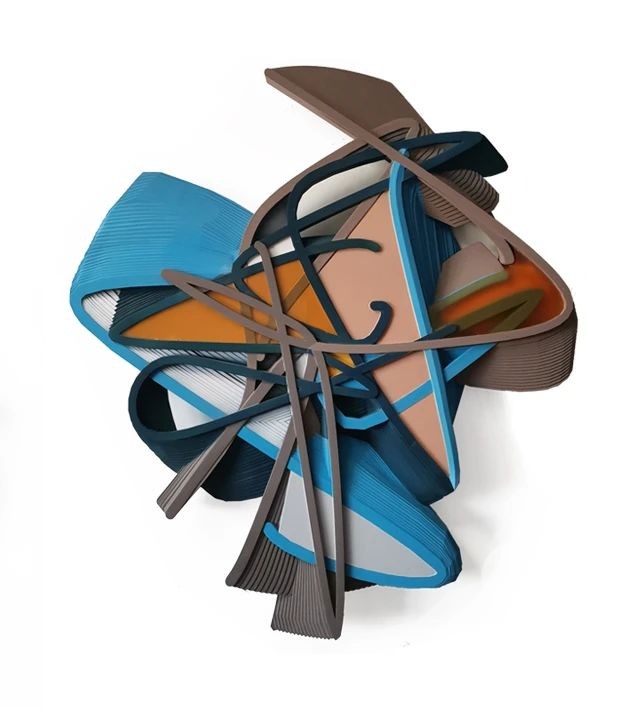
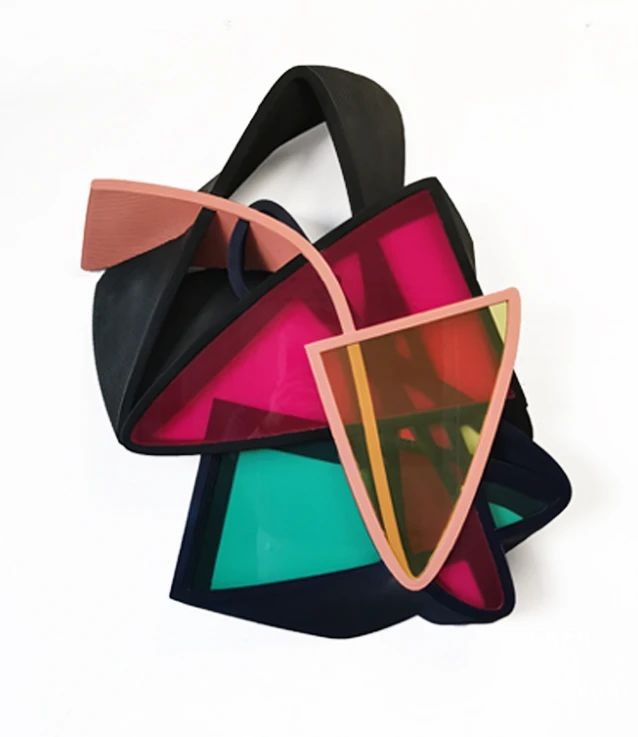

The group of works titled "Gesture Form: Topology of the Heart Symbol" (6 pieces) above the on-site pictures is an expansion and extension of the three works below, expressing concern for contemporary society and the psychological state of people. Through the combination of organic gestural forms with highly symbolized abstract expressions, the works capture the psychological landscape of contemporary society, solidifying emotional states into topological visual symbols of the heart.
"The wall serves as a boundary, but also as a bridge." As Tang Hui, Director of the Department of Mural Painting at the Central Academy of Fine Arts, said, "We read civilization in ancient murals and seek expressions in diverse media. What murals offer us is not just the precipitation of techniques, but also the broadening of our horizons and the enrichment of our souls. We draw strength from history and also cast light towards the future."
These works that have "broken out of the circle" prove that murals are no longer just decorations on walls, but a way of thinking about the world. This artistic experiment that has grown out of the Central Academy of Fine Arts may quietly reshape the creative dimensions of contemporary Chinese mural painting.


Chief Editor / He Yisha
Editor / Du Yinzhu
